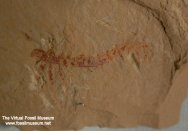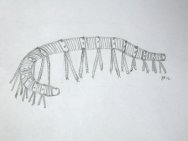Name: Luolishania
longicruris
Phylum Lobopodia
Early Cambrian (~525 million years ago)
Size: 13
mm long
Fossil
Site: Chengjiang Maotianshan Shale - Quiongzhusi Section, Yu’anshan
Member, Heilinpu Formation, Maotianshan, Yuxi, Yunnan Province, China
|  The
Lobopodians are small marine and terrestrial animals termed colloquially
“velvet worms” or “worms with legs”. While
all Recent forms are terrestrial, most fossil Lobopodians are marine,
and are known primarily from the Cambrian. Six named The
Lobopodians are small marine and terrestrial animals termed colloquially
“velvet worms” or “worms with legs”. While
all Recent forms are terrestrial, most fossil Lobopodians are marine,
and are known primarily from the Cambrian. Six named  genera,
each with a single species, are known from the Chengjiang Biota,
making it the richest source of fossils of the type on Earth. genera,
each with a single species, are known from the Chengjiang Biota,
making it the richest source of fossils of the type on Earth.
This
Lobopod comes from Maotianshan (Mao Tian Hill), site of the original
discovery of the Chengjiang Biota by Hou Xian-guang in 1984. The
specimen is most striking, and concomitantly rare; as of 2004, only
but six examples were known. A complete Luolishania is thought to
be some 15 mm long, making this specimen typical. Each leg bears
curved claws that are thought to have served the creature as an
adaptation to crawling on other organisms. Luolishania has been
found in association with Proferans. Some authors suggest that Luolishania
is most closely related to Xenusion from the Early Cambrian of Germany.
The genus is unknown outside of Yunnan Province. This fine example
has incredible detail, with its long legs clearly evident.
|
|